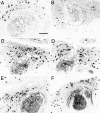Sialidase enhances spinal axon outgrowth in vivo
- PMID: 16847268
- PMCID: PMC1544173
- DOI: 10.1073/pnas.0604613103
Sialidase enhances spinal axon outgrowth in vivo
Abstract
The adult CNS is an inhibitory environment for axon outgrowth, severely limiting recovery from traumatic injury. This limitation is due, in part, to endogenous axon regeneration inhibitors (ARIs) that accumulate at CNS injury sites. ARIs include myelin-associated glycoprotein, Nogo, oligodendrocyte-myelin glycoprotein, and chondroitin sulfate proteoglycans (CSPGs). Some ARIs bind to specific receptors on the axon growth cone to halt outgrowth. Reversing or blocking the actions of ARIs may promote recovery after CNS injury. We report that treatment with sialidase, an enzyme that cleaves one class of axonal receptors for myelin-associated glycoprotein, enhances spinal axon outgrowth into implanted peripheral nerve grafts in a rat model of brachial plexus avulsion, a traumatic injury in which nerve roots are torn from the spinal cord. Repair using peripheral nerve grafts is a promising restorative surgical treatment in humans, although functional improvement remains limited. To model brachial plexus avulsion in the rat, C8 nerve roots were cut flush to the spinal cord and a peroneal nerve graft was inserted into the lateral spinal cord at the lesion site. Infusion of Clostridium perfringens sialidase to the injury site markedly increased the number of spinal axons that grew into the graft (2.6-fold). Chondroitinase ABC, an enzyme that cleaves a different ARI (CSPGs), also enhanced axon outgrowth in this model. In contrast, phosphatidylinositol-specific phospholipase C, which cleaves oligodendrocyte-myelin glycoprotein and Nogo receptors, was without benefit. Molecular therapies targeting sialoglycoconjugates and CSPGs may aid functional recovery after brachial plexus avulsion or other nervous system injuries and diseases.
Conflict of interest statement
Conflict of interest statement: No conflicts declared.
Figures




Similar articles
-
Axon regeneration inhibitors.Neurol Res. 2008 Dec;30(10):1047-52. doi: 10.1179/174313208X362523. Neurol Res. 2008. PMID: 19079979 Review.
-
Complement protein C1q modulates neurite outgrowth in vitro and spinal cord axon regeneration in vivo.J Neurosci. 2015 Mar 11;35(10):4332-49. doi: 10.1523/JNEUROSCI.4473-12.2015. J Neurosci. 2015. PMID: 25762679 Free PMC article.
-
Sialidase, chondroitinase ABC, and combination therapy after spinal cord contusion injury.J Neurotrauma. 2013 Feb 1;30(3):181-90. doi: 10.1089/neu.2012.2353. Epub 2013 Jan 21. J Neurotrauma. 2013. PMID: 22934782 Free PMC article.
-
Chondroitinase treatment following spinal contusion injury increases migration of oligodendrocyte progenitor cells.Exp Neurol. 2011 Sep;231(1):19-29. doi: 10.1016/j.expneurol.2011.05.002. Epub 2011 May 8. Exp Neurol. 2011. PMID: 21596037
-
Molecular mechanisms of scar-sourced axon growth inhibitors.Brain Res. 2015 Sep 4;1619:22-35. doi: 10.1016/j.brainres.2014.08.064. Epub 2014 Sep 1. Brain Res. 2015. PMID: 25192646 Free PMC article. Review.
Cited by
-
Immature astrocytes promote CNS axonal regeneration when combined with chondroitinase ABC.Dev Neurobiol. 2010 Oct;70(12):826-41. doi: 10.1002/dneu.20820. Dev Neurobiol. 2010. PMID: 20629049 Free PMC article.
-
Nerve regeneration restores supraspinal control of bladder function after complete spinal cord injury.J Neurosci. 2013 Jun 26;33(26):10591-606. doi: 10.1523/JNEUROSCI.1116-12.2013. J Neurosci. 2013. PMID: 23804083 Free PMC article.
-
Lentiviral-mediated knock-down of GD3 synthase protects against MPTP-induced motor deficits and neurodegeneration.Neurosci Lett. 2019 Jan 23;692:53-63. doi: 10.1016/j.neulet.2018.10.038. Epub 2018 Nov 1. Neurosci Lett. 2019. PMID: 30391320 Free PMC article.
-
Sialic acids in the brain: gangliosides and polysialic acid in nervous system development, stability, disease, and regeneration.Physiol Rev. 2014 Apr;94(2):461-518. doi: 10.1152/physrev.00033.2013. Physiol Rev. 2014. PMID: 24692354 Free PMC article. Review.
-
Brain gangliosides in axon-myelin stability and axon regeneration.FEBS Lett. 2010 May 3;584(9):1741-7. doi: 10.1016/j.febslet.2009.10.011. Epub 2009 Oct 12. FEBS Lett. 2010. PMID: 19822144 Free PMC article. Review.
References
-
- Sandvig A., Berry M., Barrett L. B., Butt A., Logan A. Glia. 2004;46:225–251. - PubMed
-
- Silver J., Miller J. H. Nat. Rev. Neurosci. 2004;5:146–156. - PubMed
-
- Yiu G., He Z. Curr. Opin. Neurobiol. 2003;13:545–551. - PubMed
-
- David S., Lacroix S. Annu. Rev. Neurosci. 2003;26:411–440. - PubMed
-
- Mears S., Schachner M., Brushart T. M. J. Peripheral Nerv. Syst. 2003;8:91–99. - PubMed
Publication types
MeSH terms
Substances
Grants and funding
LinkOut - more resources
Full Text Sources

